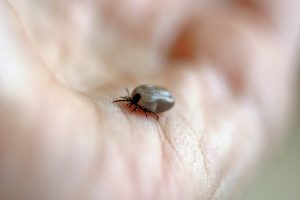
Tick season is upon us. Known to thrive in the warmer climate, ticks can be a danger to us as well as our pets. According to the Centers for Disease Control and Prevention, “State and local health departments have reported a record number of cases of tick borne disease.”
Lyme disease (a bacterial infection commonly transmitted by deer ticks) is one of the most common tick borne illnesses. If a tick is infected with the bacterium known as “Borrelia burgdorferi” and attaches to the skin undetected for a long period of time, Lyme disease can be transmitted through one’s bloodstream.
This bacterium invades the joints and causes inflammation, wearing down the cartilage of the joints. As a result, Lyme disease arthritis can develop months or even years after exposure. Arthritis.org states that, “If left untreated, over half of the people will develop sporadic bouts of arthritis, particularly in the knees.”
If detected early enough, Lyme disease can be treated effectively with antibiotics. However, Lyme disease is often misdiagnosed because it’s symptoms are commonly confused with fibromyalgia and multiple sclerosis, among others.
The Signs & Symptoms
Those with Lyme disease usually experience flu like symptoms including:
- Fever
- Chills and or sweats
- Muscle aches
- Nausea
- Headaches
- Swollen lymph nodes
- Fatigue
Most affected by Lyme disease also develop a rash in the shape of a bulls eye. More serious symptoms such as joint pain, bell’s palsy and neck stiffness can also develop.
Tick Prevention
According to NIG Medicine Plus Magazine, “A tick needs to remain attached for 36 hours before Lyme disease can be transmitted.” Therefore, avoiding tick exposure, and detecting one early on if exposed, is key in preventing Lyme disease from developing.
Small in size, ticks can easily go unnoticed. They are most prevalent in densely wooded areas, amidst high grasses, shrubs and bushes. When hiking or walking, try to keep to the center of the trail to avoid coming in contact with one. Chemical repellents and year long preventative treatment for pets are also helpful.
For further protection, dress in clothing that covers your arms and legs, tucking loose ends in to prevent any openings. Wearing light colors can help to improve a tick’s visibility.
When done spending time outdoors, be sure to check all areas of the skin including your scalp. Following a shower, wash clothes in high heat to kill any ticks that may be remaining.
Removing a Tick
If you do find a tick, it is critical that it is removed properly and quickly. Use tweezers to grab the whole tick, being careful to pull it out directly without twisting as the head could remain in the skin. Afterwards, clean the area with soap, water and rubbing alcohol. You can get rid of the tick by flushing it down the toilet or sealing it in a bag.
For more questions about Lyme disease as well as the treatment for Lyme arthritis or joint pain, contact Dr. Stacie Grossfeld and the Orthopaedic Specialists of Louisville, Kentucky at 502-212-2663.

Recent Comments